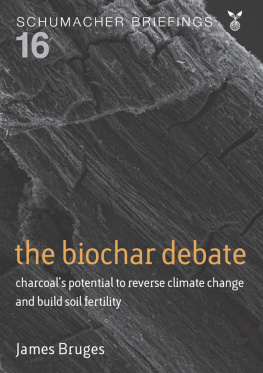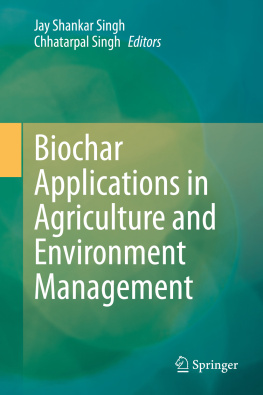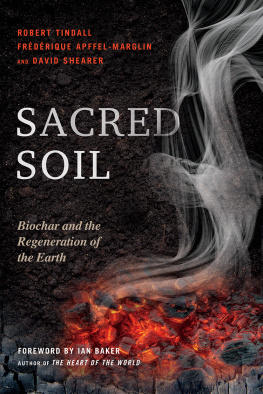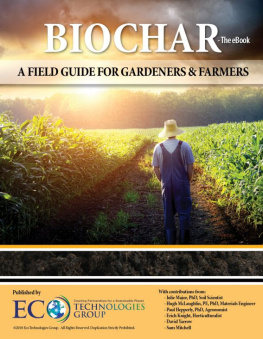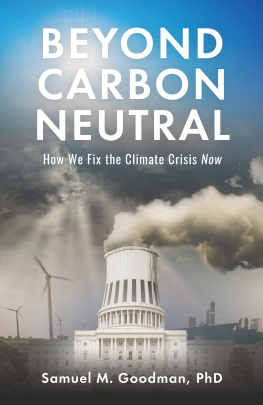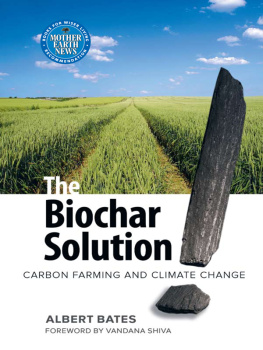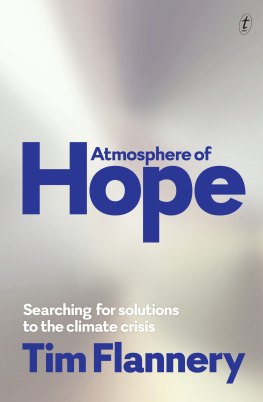
Contents
Chapter 1
Introduction
Charcoal and biochar
Charcoal is one of the oldest industrial technologies, perhaps the oldest. In the last decade there has been a growing wave of excitement engulfing it. Why?
Because some scientists are saying that we might be saved from the worst effects of global warming if we bury large quantities of it. Not only that: we can restore degraded land and get better harvests by mixing fine-grained charcoal biochar with soil. Others say that charcoals use could be just one of several technologies to mitigate climate change. Yet some maintain that it is an extremely dangerous technology. The jury is out on which is closest to reality. This Briefing aims to provide an overall view of the subject and describes the best way to encourage the appropriate use of biochar.

The theory is simple. Plants, through photosynthesis, capture carbon dioxide the main greenhouse gas from the air as they grow. The carbon of CO2 provides their structure and the oxygen is released for animals to breathe. If the plants are left to rot, the C and O combine again in a relatively short time to release carbon dioxide back into the air. However, if the plants are burned in the absence of oxygen called pyrolysis charcoal is formed. Charcoal is largely carbon. As anyone who has organised a barbecue knows, charcoal can be burned, in which case the gases go back up into the atmosphere. But if it is buried, the two elements take a long time to recombine as carbon dioxide. This means that some of the most pervasive greenhouse gas can be taken out of the atmosphere and locked into the ground for a long time. Deep burial rather like putting coal back where it belongs is one way. But there is another option.
Additional excitement came with the discovery of deep dark areas of terra preta do indio Indian black earth in the Amazon rainforest where the soil generally is thin, red, acidic and infertile. The patches of terra preta are alkaline with a high carbon content, and contain pot-shards indicating that it was not natural: a pre-Columbian civilisation had created it. It is extracted and widely used by garden contractors because it is so fertile. It has remained fertile and retained its carbon content through the centuries.
Terra preta is black because it contains large amounts of charcoal. Infertile land had been converted to fertile land that supported a thriving civilisation through the wise use of the trees that had been felled. Could charcoal, therefore, not only be a vehicle for reducing global warming but also a means to increase the fertility of degraded land, and help feed the world?
Charcoal used for this purpose is referred to as biochar. Biochar is pulverised charcoal made from any organic material (not just wood) and, when mixed with soil, it enhances its fertility. It locks carbon into the soil and increases the yield of crops. To many this appears the closest thing to a miracle.
The process of converting plant material to charcoal gives off heat together with gases and oils. Certain plants and certain processes produce a high proportion of charcoal, whereas others produce more gases and oils. This is where the problems start. These chemicals could become the main commercial attraction of biochar. As has been found with biofuel, growing crops to fuel cars can be more profitable than growing food to feed people. If left to the market, producers of biochar might buy up productive land, plant monocultures, and develop their equipment primarily to produce fuel and industrial chemicals.
Then there is the suggestion that the burial of charcoal should earn carbon credits. As above, the financial motive could lead to growing carbon credits in preference to growing food. And if widely adopted, as hoped, the carbon market would be flooded with credits; industry would buy them at knock-down prices and carry on with business as usual to the detriment of the climate. A strong financial incentive to use biochar is desirable, but carbon credits may not be the best approach.
There are two prime objectives. It is essential to find ways to sequester greenhouse gases if we are to avoid the worst effects of global warming. It is essential also to enable farmers throughout the world to use biochar if it can bring degraded land back to fertility and increase yields. The process cannot be left to the market, which has been described as an out-of-control demolition ball swinging from a high crane.
In the final chapter I outline twin policies for reducing greenhouse gases in the atmosphere. The first policy would ensure a reduction in the use of fossil fuels. The second concerns our use of land. The requirements for the two are so different that separate regulations are necessary. The first is called cap-and-share (in Europe). The second is the Irish proposal for a Carbon Maintenance Fee (CMF), which would provide a powerful incentive for every country, rich and poor, to enable its farmers, businesses and individuals to maintain land-based carbon.
A visit to India

A typical Indian village.
I had been caught up in the excitement surrounding biochar before visiting India in January 2008. While there I asked everyone I met about the production and use of charcoal. My obsession was embarrassing for my wife Marion, but paid off when it led to meeting Dr Ravikumar of the Centre for Appropriate Rural Technology (CART) in Mysore. He talked about a charcoal revolution that would bring employment to the rural poor. He had been working on stoves to produce charcoal in the absence of oxygen for about eight years at CART. But CART was closing, so he was looking for an organisation to promote the development of his ideas. I suggested he contacted our friends Amali and Cletus Babu who had started the nongovernmental organisation SCAD, Social Change and Development, in the southern tip of India 25 years earlier. Their objective is also to bring knowledge and employment to communities in the 450 villages where SCAD works.

Demonstrating Ravis Anila stove.
Later David Friese-Greene, while visiting SCAD, was taken to meet some banana growers who had been adding charcoal dust to their crops during the last four years. They had tried this quite by chance, having come across a supply of almost free charcoal made from rice-husks as a by-product of some other process. They told David that digging it in with the banana plants cut the amount of irrigation water needed in half and doubled the yield of their crop. Maybe there was a bit of exaggeration here I dont know. They added that the bananas taste better. In Britain we only receive one kind of banana, referred to by our Indian friends as tasting like expanded polystyrene, but there is a great variety in south India and the different tastes are appreciated and affect sales. Neighbouring farmers have been impressed with the results and are adopting their practice.
The fact that burying charcoal extracts carbon dioxide from the atmosphere is of little significance to SCADs farmers. They are only interested in increasing the yield of their crops. If this can be clearly demonstrated to, or by, farmers, and if the equipment for producing the charcoal were affordable and available, the practice would spread naturally.
Next page
